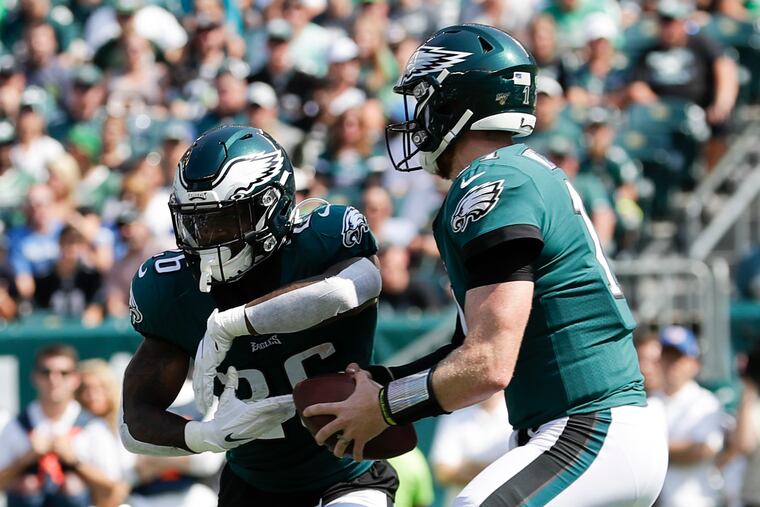The Eagles are serious about play-action, as Carson Wentz’s stats show
Carson Wentz is a much more effective passer when he can fool defenses with the threat of a run.

The Eagles won’t always be able to run the ball as easily and effectively as they did last week at Green Bay, but demonstrating that they are capable of piling up a 176-yard rushing game ought to yield benefits.
Play-action is one of Carson Wentz’s most effective weapons. The Eagles have used it on 22.2% of their passing snaps this season, according to Pro Football Focus. Wentz’s completion percentage using play-action, in which a quarterback fakes a handoff as he drops back but keeps the ball and passes, is 69.7, compared with 58.0 on dropbacks that don’t involve play-action. Both of Wentz’s 2019 interceptions have come on plays without play action.
Among quarterbacks who have played in four games this season, only Dallas’s Dak Prescott, the Chargers’ Philip Rivers, and Jacksonville phenom Gardner Minshew have a bigger differential between play-action completion percentage and non-play-action completion percentage.
Wentz has a 98.4 passer rating with play-action, 94.3 without. His top receiver, tight end Zach Ertz (24 catches, 255 yards), said freezing opposing linebackers even briefly helps Ertz’s cause.
“When you’re running a lot of routes over the middle of the field, if the linebackers are out of the way, it’s a lot easier, if they’re biting up on the run fake. And Carson’s extremely talented, so that helps,” Ertz said as the 2-2 Eagles prepared for their home game Sunday against the 0-3 New York Jets. “I just think it’s something we can hang our hats on consistently. ... But you got to be able to run the ball” to make it work.
Fellow tight end Dallas Goedert added that making defenders hesitate before rushing the passer helps give time for receivers making double moves downfield, or just for someone such as himself to get out of a block and make a quick catch.
“We have some plays where if the linebackers step up, we can just get the ball right behind their ear. … I think we’ve been great at it this year,” Goedert said. “It kind of depends on whether the coaches are able, formationally, make the run look like the pass.”
Wentz’s play-action numbers were even better last season, when the Eagles used in on 32.1% of his snaps – he completed 74.8% of his passes with play action, 67.2% without.
Center Jason Kelce said play-action “is an incredible tool for any offense,” not just the Eagles'. “If you really look at it, linebackers are in a predicament. In a lot of defenses, they’re asked to play the run and also play the pass, at much different levels. You got yp run through the gap on the run play, then the next second you got to drop to a hook-to-curl 10 yards off the ball. That’s a lot to ask of a player.”
Run-pass options serve much the same purpose, but obviously, with play-action, there’s no option for the play to become a run.
As Ertz said, the run threat has to be credible – often a complaint of Andy Reid’s critics when he coached the Eagles -- but also, the offensive line needs to not be transparent. If the quarterback is reaching the ball out to the running back but his linemen have already set up to pass-block, an astute linebacker is going to know the run isn’t happening.
“There’s tells – some teams, guys give away things in their stances, or based on formation, [the defense] might have a pretty good idea,” Kelce said. “You try to make it look the same … so they have to play it honest.”
Right guard Brandon Brooks said the key is “to sell the run – to get the linebackers to bite and think it’s a run. Not ‘high hats.’ Low hats, sell the run, so linebackers bite up and the routes behind them get open.”
Brooks said offensive line coach Jeff Stoutland is to thank for the Eagles’ being good at not giving away their intentions.
“He’s a stickler for all the little things,” Brooks said.
Brooks identified the Rams, whose offense is widely lauded around the league, as being another team that runs play-action well. Not coincidentally, they employ Todd Gurley at running back.
“When teams are scared of your run game, they’re coming downhill a little bit faster,” Brooks said.
How does the poor linebacker deal with this?
“A lot of it comes down to reading your keys,” Eagles linebacker Nate Gerry said. “A lot of people coach [visualizing] a triangle between your spot and a guard or a tackle, and then the running back being the top of the triangle, and you kind of just see the big picture.
“Another [key] would be offensive linemen coming out and getting upfield, obviously, because you can’t get upfield on a pass. And reading the mesh point,” where the quarterback and the running back come together.
Gerry said sometimes the running back hustles over to pick up a blitzer and the quarterback ends up faking a handoff to empty space, which is not going to create mass confusion.
Gerry said he thinks the Eagles are good at play-action because an opposing defense “has to honor a lot of people” – backs and receivers – “and I think we’ve got a really talented group on the offensive line, so [the defense] is worried about getting in their gaps and being able to stop the run.”